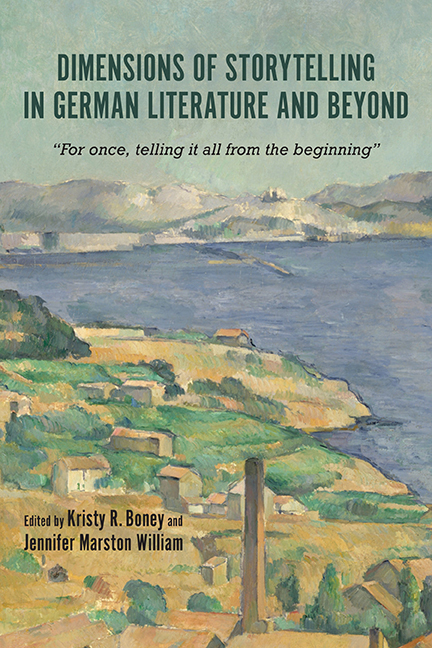 Dimensions of Storytelling in German Literature and Beyond
Dimensions of Storytelling in German Literature and Beyond Book contents
- Frontmatter
- Contents
- Acknowledgments
- Introduction: The Social, Political, and Personal Dimensions of Storytelling
- Part I Anna Seghers: A Missing Piece in the Canon of Modernist Storytellers
- Part II Expressions of Modernity: Using Storytelling Unconventionally
- 8 Storytelling and Telling Stories in Heine's Prose Fiction
- 9 Modernist Haze: Topographical Textures in Paul Klee and Franz Kafka
- 10 Synthesis and Transtextuality: The Jewish Reinvention of Chinese Mythical Stories in “Shanghai Ghetto”
- 11 American Children Writing Yiddish: The Published Anthologies of the Chicago Sholem Aleichem Schools
- 12 A Literary Depiction of the Homeland of Jews in Czechoslovakia and East Germany after 1945
- 13 Changed for the Better? Alternative Uses of the Transformative Cancer Trope in Thomas Mann's Die Betrogene and Nadine Gordimer's Get a Life
- Part III The Personal Narrative: Storytelling in Acute Historical Moments
- Notes on the Contributors
- Index
8 - Storytelling and Telling Stories in Heine's Prose Fiction
from Part II - Expressions of Modernity: Using Storytelling Unconventionally
Published online by Cambridge University Press: 12 April 2019
- Frontmatter
- Contents
- Acknowledgments
- Introduction: The Social, Political, and Personal Dimensions of Storytelling
- Part I Anna Seghers: A Missing Piece in the Canon of Modernist Storytellers
- Part II Expressions of Modernity: Using Storytelling Unconventionally
- 8 Storytelling and Telling Stories in Heine's Prose Fiction
- 9 Modernist Haze: Topographical Textures in Paul Klee and Franz Kafka
- 10 Synthesis and Transtextuality: The Jewish Reinvention of Chinese Mythical Stories in “Shanghai Ghetto”
- 11 American Children Writing Yiddish: The Published Anthologies of the Chicago Sholem Aleichem Schools
- 12 A Literary Depiction of the Homeland of Jews in Czechoslovakia and East Germany after 1945
- 13 Changed for the Better? Alternative Uses of the Transformative Cancer Trope in Thomas Mann's Die Betrogene and Nadine Gordimer's Get a Life
- Part III The Personal Narrative: Storytelling in Acute Historical Moments
- Notes on the Contributors
- Index
Summary
NOT ALL GREAT WRITERS are great storytellers, especially not in the traditional sense of storytelling. In order to construct a story, a writer has to possess specific talents and a certain temperament. A good story must have a beginning, a middle, and an end. It must cohere to the extent that characters are consistent psychologically throughout the various phases of the story. The actions and activities of the characters must be motivated by a credible psychology, and the events must develop in a logical pattern. Elements of the story must be carefully arranged to elicit reader responses. Often suspense is a reaction storytellers seek to evoke, and for each reaction the author is trying to provoke in the audience, he or she must apply appropriate techniques. Narration must demonstrate the same type of relationship to characters throughout, and the narrator has to remain consistent in tone and level of diction. If the writer is composing a short story or a novella, we will often find a focus on one event or a series of related events, but even in cases of shorter prose fiction we count on consistency in characters and character development, logical plots, and psychological credibility. With longer prose fiction, such as novels, there are additional demands for attention to detail and development. The reader expects an exposition when new characters are introduced, or when the scene shifts from one place to another. Descriptions must be consistent from one part of the novel to another. Obviously some modernist tendencies in prose fiction play with these conventions, intentionally disappointing readers’ expectations and the norms that have become established for fiction. But even in the case of the deviation from narrative norms, the writer must display a command that allows the reader to appreciate the deviation as part of the compositional strategy. If the deviation from norms and consistency appears to result from a mistake or deficient capacity, then the writer fails to accomplish his purpose and will be considered lacking in talent.
It is quite possible to imagine a writer who is constitutionally unable to accomplish storytelling in this traditional sense, yet who is an outstanding prose stylist and insightful author. Heinrich Heine is a case in point.
- Type
- Chapter
- Information
- Dimensions of Storytelling in German Literature and Beyond“For once, telling it all from the beginning”, pp. 111 - 121Publisher: Boydell & BrewerPrint publication year: 2018
